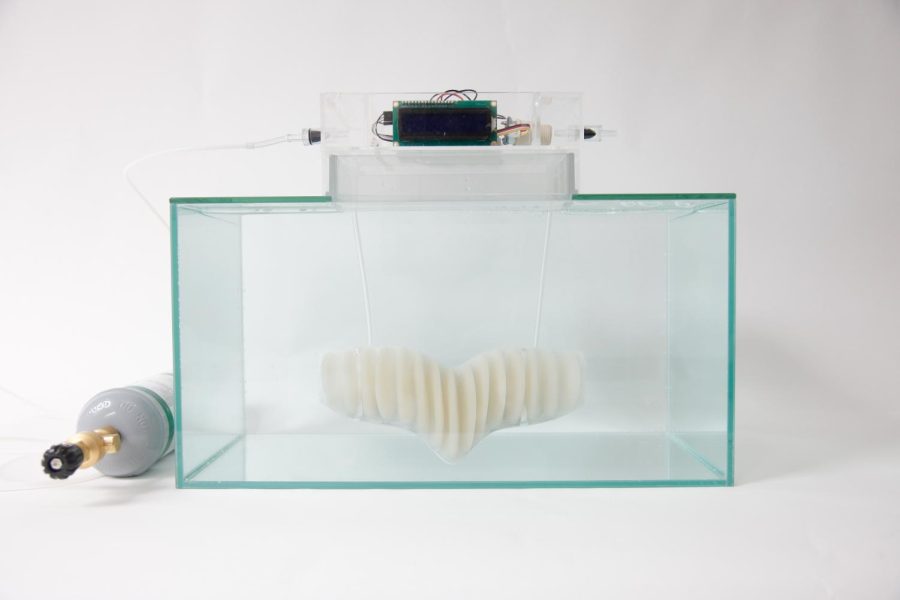The world of high-end fashion is bizarre and wonderful, but only the most outlandish designs end up in mainstream news.
Paris Fashion week is known for showcasing jaw-dropping high fashion. This year, an innovative and daring Coperni dress sprayed onto Bella Hadid made headlines. Hadid began nearly naked, but within 15 minutes was walking down the runway wearing a dynamic white slit dress design by Coperni founders Sébastien Meyer and Arnaud Vaillant.
The internet went crazy.
Senior Alexa Hall saw the dress on TikTok. “I thought it was weird and interesting,” she said. “I wondered what it was made out of because I hadn’t seen anything like that before.”
While Hadid’s innovative dress may have captured the temporary attention of the internet, the design industry has long been at the intersection of engineering and art. From biomimicry to recycled non-woven material, designers have applied their creativity to engineer advanced materials with applications on and off the runway.
Hadid’s dress was created from a material called Fabrican, which was originally developed in 2003 at Imperial College in London. The concept of Fabrican was dreamed up by Dr. Manel Torres, who wanted to take the concept of silly string and make a fine, spider web-like material that would create a fabric when sprayed.
This idea became Fabrican, a non-woven fabric made from biopolymers, binders and cross-linked fibers. According to their website, Fabrican is made from “greener, non-volatile organic compounds” and “uses no ozone depleting substances,” making it another example of the movement toward environmentally-conscious design in high-end fashion. Additionally, the fibers of Fabrican are made from “fibers recycled from discarded clothes and other fabrics,” and can be “redissolved and reused, or disposed of for biological degradation into simple molecules under industrial composting conditions.”
Fabrican is also more than a fashion designer’s new favorite toy. Because it is sprayed from an aerosol can, it is sterile, and therefore can be used in the medical industry. The fibers of Fabrican can be modified to make hard casts or soft, flexible bandages. Fabrican also has potential applications in areas as diverse as the cleanup of oil spills, the renovation of car upholstery and the delivery of transdermal drugs.
Sophomore Katie Haas has goals of working in pediatric healthcare. “I think there’s a high possibility of Fabrican developing a significant role in the medical industry; its sustainability and versatility are pretty promising,” she said. “The recent innovations in fashion are definitely something to be celebrated.”
AMPHIBIO, designed by biomimicry designer and materials scientist Jun Kamei, is another innovation combining design and science. He describes the AMPHIBIO as “a 3D printed amphibious garment which functions as a gill.”
The appearance of AMPHIBIO is a sleek, semi-transparent mask that slips over the mouth and nose of the user so that they may breathe underwater. Kamei’s technology “supports underwater breathing by replenishing oxygen from the surrounding water and dissipating carbon dioxide which accumulate in the system.” He drew inspiration from the gills of water diving insects.
AMPHIBIO is not just a way for its designer to indulge his imagination. In 2100, over 630 million people will live on land below projected flood levels. With this prediction comes a possibility that humans will need to stay underwater for long periods of time on a regular basis. Providing a comfortable way to do so was Kamei’s goal.
AMPHIBIO is still a working prototype, only tested in a small aquarium and not yet tested on humans.
Individual projects like Kamei’s are contrasted by mass-produced innovations such as Nike Forward. Nike Forward is not a small-scale prototype– it is arguably the biggest step in innovation the biggest fashion brand in the world has taken toward sustainability.
Nike Forward is a non-woven material created by needle-punching machines traditionally used in the automotive industry. These machines attach fibers from recycled plastic flakes directly to one another. This single action replaces the multi-stage process used to create traditional woven fabric, thus reducing the amount of energy consumption. Nike asserts this reduction in energy translates to a 75% reduction in the carbon footprint compared to the production of traditional fleece.
Nike Forward’s initial release was limited to a gray hoodie or crew neck which became available on Sept. 15.
Sophomore Grace Boleyn is an avid Nike fan and is interested in their new technology. “I think this is very innovative of Nike and it is interesting to see how other brands are responding to the public eye on climate change,” she said. While Boleyn has never seen or felt Nike Forward material in person, she would be open to buying one depending on the quality and feel of the material.
The intersection of design, engineering and sustainability has thus far produced a multitude of intriguing yet practical products, making for an exciting period of innovation in both fashion and technology.









